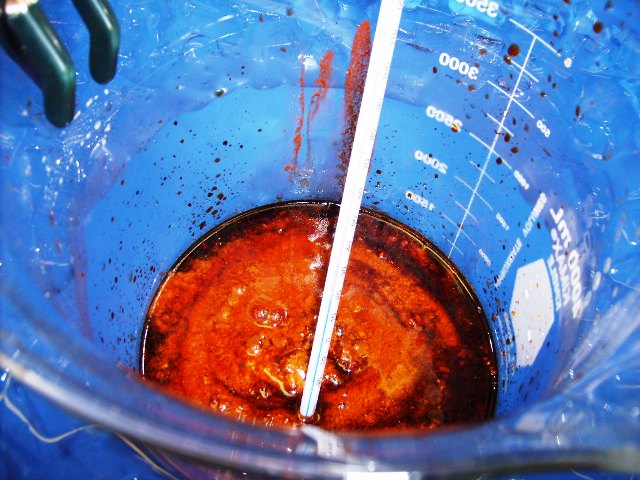Many times when Palladium is precipitated the solution contains base metals like iron, copper, and nickel. Like gold that is precipitated from a dirty solution, the resulting Palladium Ammonium Chloride will drag down metals from the dirty solution with the resulting brick red Palladium salt.
Here's a photo of such a precipitation:

and the resulting dry palladium salt:

Hoke describes a method of cleaning the dirty Pd salt using ammonium hydroxide( NH4OH). She mentions using aqua ammonia (28% concentration), but I have found that a 10% solution of ammonium hydroxide will work equally well.
The first step is to dissolve the dirty Pd salt in NH4OH. When the NH4OH is first added the Pd salt will turn to a orange flesh colored salt. As more ammonium hydroxide is added with stirring the flesh colored salt will dissolve into a nearly clear yellow tinted solution. Some solids may remain behind.
At this point allow the solution to sit for a least one hour or until no more of the solids will dissolve with a fresh dose NH4OH and stirring. Use only enough NH4OH to dissolve the flesh colored precipitate. Depending on the contaminating metal you may see various colored solids in the bottom of the beaker. Iron leaves brown fluffy residue, copper colors the solution slightly blue, tin leaves a white pasty material. Some of the other platinum sister metals will also leave colored solids behind. Typically these PGM salts will be red, orange, yellow, and possibly even drab green colored depending on the PGM and the contaminates in the solution.
Now the solution is filtered with a vacuum filter rig and rinsed with a small amount of ammonium hydroxide. The filtered solution should be nearly clear with a slight tint of yellow.
Here's a snapshot of the contaminates removed from the Pd salt in the first two photos:

Now that most of the impurities have been removed you can slowly add 32% HCl (muriatic acid) to the solution to precipitate the clean Pd salt. Add enough HCl to make the solution acidic. Add the HCl slowly as the solution will rapidly heat and may foam up. Allow the solution to set for at least one hour.
Here's the clean Pd salt precipitating:

Now vacuum filter the clean yellow Pd salt out of the solution and allow to dry. Test a drop of the solution with DMG to be certain all of the Pd has been removed.
Here's the filter of clean Pd salt:

You can repeat this process to further purify the Pd if you like.
The resulting yellow Pd salt is now converted to Pd sponge via your favorite method, then melted under a hydrogen flame if desired.
Steve
Here's a photo of such a precipitation:

and the resulting dry palladium salt:

Hoke describes a method of cleaning the dirty Pd salt using ammonium hydroxide( NH4OH). She mentions using aqua ammonia (28% concentration), but I have found that a 10% solution of ammonium hydroxide will work equally well.
The first step is to dissolve the dirty Pd salt in NH4OH. When the NH4OH is first added the Pd salt will turn to a orange flesh colored salt. As more ammonium hydroxide is added with stirring the flesh colored salt will dissolve into a nearly clear yellow tinted solution. Some solids may remain behind.
At this point allow the solution to sit for a least one hour or until no more of the solids will dissolve with a fresh dose NH4OH and stirring. Use only enough NH4OH to dissolve the flesh colored precipitate. Depending on the contaminating metal you may see various colored solids in the bottom of the beaker. Iron leaves brown fluffy residue, copper colors the solution slightly blue, tin leaves a white pasty material. Some of the other platinum sister metals will also leave colored solids behind. Typically these PGM salts will be red, orange, yellow, and possibly even drab green colored depending on the PGM and the contaminates in the solution.
Now the solution is filtered with a vacuum filter rig and rinsed with a small amount of ammonium hydroxide. The filtered solution should be nearly clear with a slight tint of yellow.
Here's a snapshot of the contaminates removed from the Pd salt in the first two photos:

Now that most of the impurities have been removed you can slowly add 32% HCl (muriatic acid) to the solution to precipitate the clean Pd salt. Add enough HCl to make the solution acidic. Add the HCl slowly as the solution will rapidly heat and may foam up. Allow the solution to set for at least one hour.
Here's the clean Pd salt precipitating:

Now vacuum filter the clean yellow Pd salt out of the solution and allow to dry. Test a drop of the solution with DMG to be certain all of the Pd has been removed.
Here's the filter of clean Pd salt:

You can repeat this process to further purify the Pd if you like.
The resulting yellow Pd salt is now converted to Pd sponge via your favorite method, then melted under a hydrogen flame if desired.
Steve





